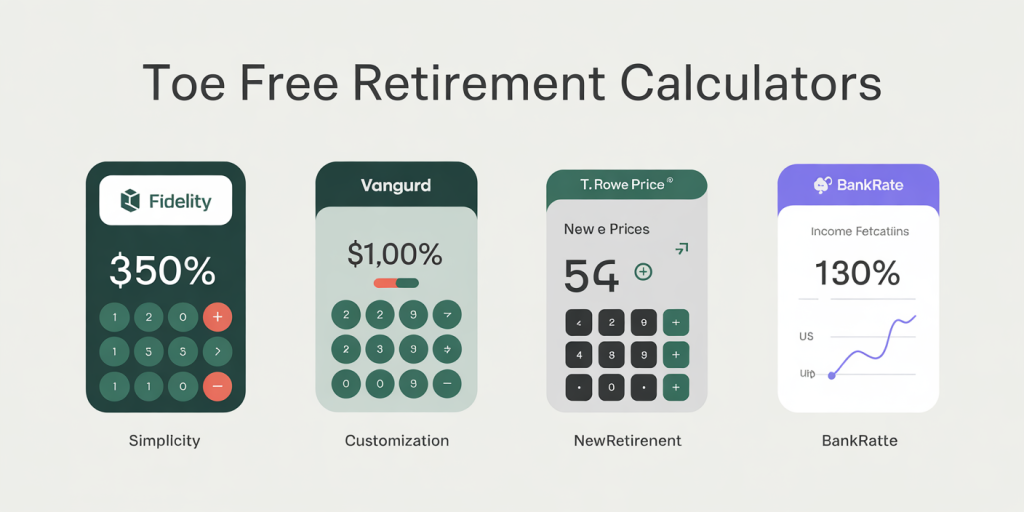Free Tools to Simulate Retirement Savings and Future Income
Planning for retirement is a crucial financial milestone that requires thoughtful preparation and accurate forecasting. Individuals often face uncertainty regarding how their current savings behavior, expected returns, inflation, and spending habits will affect their financial stability post-retirement. Thankfully, numerous free online tools have emerged to assist in simulating retirement savings and estimating future income, providing valuable insights without the cost of professional financial advice. These tools empower users to model different saving scenarios, investment strategies, and retirement ages, helping to build confidence and optimize plans for a secure retirement future.

The growing reliance on digital calculators and simulation platforms aligns with data showing that nearly 60% of Americans feel underprepared for retirement, according to a 2023 survey by the Insured Retirement Institute. By utilizing simulation tools, retirees or soon-to-be retirees can visualize their financial outcomes, adjust parameters, and better understand the impact of variables such as inflation rate, market volatility, and social security benefits. This article explores the best free resources available for retirement planning simulations, compared by features and user-friendliness, illustrated with practical examples and data-driven comparisons.


Why Simulation Tools are Vital for Retirement Planning
Retirement planning involves multiple complex factors, including current savings, expected investment growth, longevity risk, healthcare costs, and desired post-retirement lifestyle. These variables interact in non-linear ways, making manual calculations cumbersome and prone to errors. Free retirement simulation tools help bridge this gap by providing dynamic, real-time feedback on financial health projections based on customizable inputs.
For example, a 35-year-old professional earning $60,000 annually who contributes 10% to a retirement fund needs to understand how various investment returns (say, from 5% to 8%), inflation scenarios, and retirement ages (from 62 to 67) affect her expected retirement corpus and lifetime income. Simulation tools enable her to enter these assumptions, instantly seeing outcomes and adjusting her savings strategy accordingly. Such clarity can encourage increased savings rates or diversification into retirement-specific investments such as IRAs or 401(k)s.
Moreover, given increased longevity—U.S. adults turning 65 years old today can expect to live another 20 years on average according to the CDC—accurate simulations ensure people do not outlive their assets. Free tools often include mortality tables and withdrawal rate analyses helping users avoid the “sequence of returns risk,” which means withdrawing funds during market downturns, potentially depleting savings prematurely.
Top Free Retirement Simulation Tools: Features and Benefits
A variety of free retirement calculators exist online, ranging from simple savings estimators to comprehensive planning systems integrating social security, pensions, and taxation. The table below compares five widely recognized free tools, highlighting their core features, usability, and unique advantages:
| Tool Name | Key Features | User-Friendliness | Best For |
|---|---|---|---|
| Fidelity Retirement Score | Simple data input, personalized retirement scores, includes Social Security projections | Intuitive interface | Beginners and intermediate savers |
| Vanguard Retirement Nest Egg Calculator | Focuses on withdrawal strategies and portfolio longevity | Moderate, clear explanations | Portfolio longevity analysis |
| T. Rowe Price Retirement Income Calculator | Comprehensive income forecasting with tax impact | Step-by-step guidance | Detailed tax and income planning |
| NewRetirement Planner | Highly customizable with scenarios for various income streams and expenses | Advanced but user-friendly | Detailed, scenario-based planning |
| Bankrate Retirement Calculator | Basic savings and income projection based on inputs | Very straightforward | Quick estimates and initial planning |
For instance, Fidelity’s calculator provides a “retirement score” which rates your preparedness on a scale of 1 to 100. Users entering $500,000 in retirement savings, planning to retire at 65 with $50,000 in annual expenses, can receive tailored advice on how much to save monthly or adjust retirement age for financial stability.
Vanguard’s tool is uniquely helpful for retirees deciding safe withdrawal rates (SWR), often recommended between 3-4% annually. Their simulation models portfolio sustainability over decades, helping prevent depletion of funds during market slumps.
Practical Examples of Using These Tools
Consider John, a 45-year-old engineer planning to retire at 67. He currently has $200,000 saved and contributes $1,000 monthly to his 401(k) with an expected average annual return of 7%. Using the NewRetirement Planner, he inputs these values along with expected Social Security benefits starting at 67, estimated at $1,800 per month. The tool’s scenario-based approach lets him simulate different retreat ages, contribution increases, and changing expense projections.
John finds that by increasing contributions by 15%, he could comfortably generate a $60,000 annual retirement income, with a buffer of emergency funds lasting into his 90s. This customization helps him decide not only how much to save but when to start Social Security to maximize benefits.
Similarly, Maria, a 30-year-old freelance graphic designer, uses the Bankrate Retirement Calculator to set simple targets. Inputting her current savings of $15,000, expected retirement age of 65, and desired retirement income of $40,000 per year, the tool suggests how much she should save monthly to meet her goals, factoring average inflation of 3%. She quickly learns she needs to save approximately $550 monthly, which she can incorporate into her budget planning.
By using multiple tools, both John and Maria benefit from cross-validation of their assumptions, improved confidence, and a clear action plan.
Understanding the Limitations and Assumptions in Simulation Tools
While free retirement calculators are powerful, users must be aware of inherent limitations. Most models rely on assumptions such as fixed average rates of return, steady inflation rates, and consistent spending habits. However, real-life markets are unpredictable and inflation fluctuates, especially in volatile economic climates.
For example, the average historical return of the S&P 500 has been approximately 10% annually over the last century but including downturns such as the 2008 financial crisis or the 2020 pandemic-induced crash can dramatically affect results if these years coincide with early retirement withdrawals.
Moreover, simulation tools rarely account comprehensively for unforeseen expenses like major health care costs, long-term care, or changing tax laws. Social Security estimates may differ due to policy changes. Withdrawal strategies in most tools assume rational behavior, while emotional or necessity-driven decisions may cause deviations.
A study by the National Bureau of Economic Research (NBER) highlights that 40% of retirees underestimate health-related expenses, suggesting a need to incorporate conservative buffers in simulations. Therefore, while these tools provide valuable insights, users should regularly update their inputs and consider consulting financial planners for complex cases.
How to Choose the Right Simulation Tool for Your Needs
Selecting an appropriate retirement simulation tool depends on individual financial literacy, complexity of personal finances, and specific planning goals. Beginners or those seeking quick estimates will benefit from simpler calculators such as Fidelity’s Retirement Score or Bankrate’s basic model. These require minimal data, produce understandable outcomes, and coach users toward actionable steps.
For individuals with more sophisticated financial situations involving multiple income sources, pensions, tax considerations, and varying retirement goals, tools like NewRetirement Planner or T. Rowe Price’s calculator provide advanced options. These allow users to create customized cash flow scenarios, model tax impacts, and evaluate investment strategies.
Additionally, consider tools that are updated regularly to reflect current economic conditions, tax rules, and Social Security data. User reviews and mobile compatibility should also be factors, as on-the-go access facilitates frequent plan reviews.
Performing trial runs with multiple simulators aids in identifying discrepancies and enhances overall retirement readiness. For instance, comparative simulations by a 55-year-old couple revealed that Vanguard’s withdrawal-focused model suggested a lower sustainable annual spending than NewRetirement’s detailed plan, prompting them to revise expectations and increase contributions.
Future Perspectives: The Evolution of Retirement Simulation Tools
Retirement simulation technology is rapidly evolving with artificial intelligence (AI) and machine learning shaping more personalized and adaptive tools. Emerging platforms promise real-time adjustments based on market trends, spending behaviors, and economic shifts, offering increasingly precise forecasts.
Integration with fintech apps that track expenses, debts, and income streams facilitates continuous retirement readiness reviews. This “living” planning approach ensures users react proactively to changes rather than relying on static plans.
Moreover, advancements in behavioral economics are being incorporated into newer models which anticipate common human biases such as procrastination or risk aversion, providing tailored nudges to improve saving habits. Virtual reality (VR) experiences simulating retirement scenarios are also being explored to make planning more tangible and engaging.
Government agencies and private firms alike are investing in expanding the accessibility and interactivity of these tools, ensuring broader demographics benefit from retirement preparedness. For example, the Social Security Administration has updated its online calculators to include cost-of-living adjustments and break-even analysis for claim timing.
In a world where longevity is increasing but economic certainty remains elusive, leveraging next-generation free retirement simulation tools will be essential for individuals aiming to secure their financial futures confidently.
